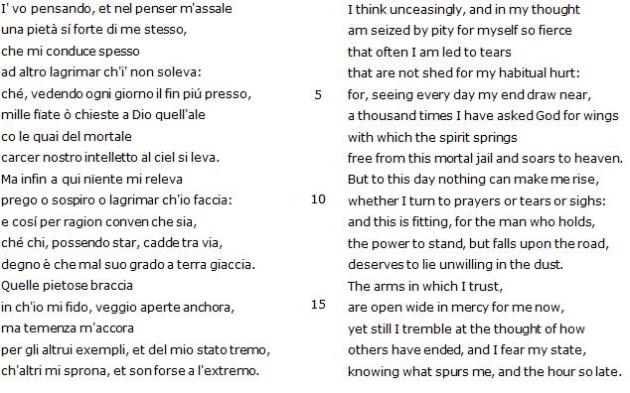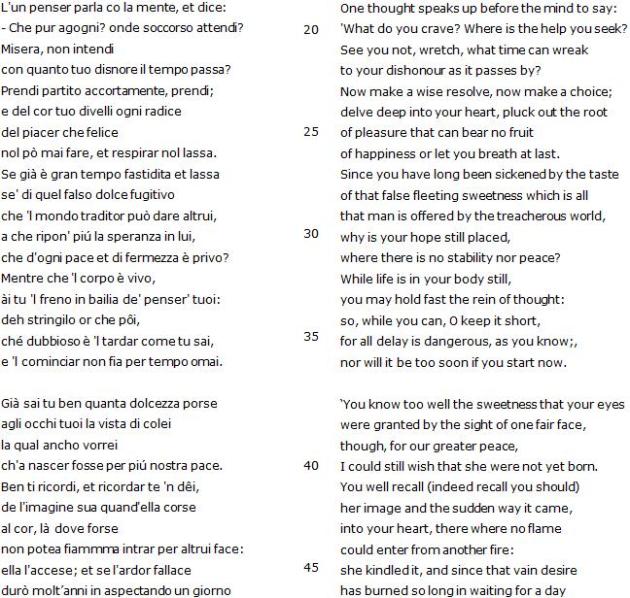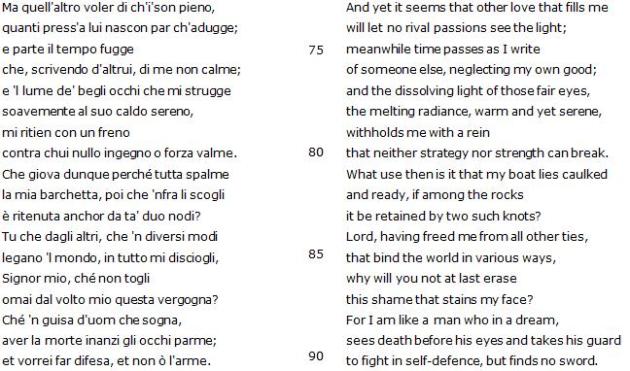Canzoniere 23
May 8, 2012 2 Comments
For the Italian text, please click here.
For an English translation by A.S Kline, please click here.
Presentation by David Bowe
(Report by Jennifer Rushworth):
The poem enacts a destabilisation of identity and self-image, foregrounding the endless mutability of the lyric subject and thus deconstructing the textual ‘io’. The poet attempts to answer the question ‘che son? che fui?’, v.30.
Rewriting Ovid’s Metamorphoses, Petrarch’s lyric self is transformed in turn from laurel to swan to stone to fountain to flint to voice to deer. The specific myths he draws on are Daphne; Cygnus; Battus; Byblis; Echo; Actaeon. In all these, the lyric subject is in a passive position. The importance of Echo will be remembered from the previous week’s session, on RVF 45. The first metamorphosis is particularly interesting because here the ‘io’ takes the usual place of Laura, perhaps in an act of identification with the loved object, or perhaps with its association with enduring poetic fame in mind (‘un lauro verde / che per fredda stagion foglia non perde’, vv.39-40). It is this first metamorphosis which is privileged as the most significant and lasting one at the end of the poem: ‘né per nova figura il primo alloro / seppi lassar’ (vv.167-168). Laura is figured as Medusa in this poem (‘Questa che col mirar gli animi fura’, v.72) as she is RVF 366 (vv.111-12), although her identity is also called into question (‘“I’ non son forse chi tu credi”’) and is ultimately as unstable and changeable as that of the lyric ‘I’.
The poem presents several important points of resonance with Dante, with the Dante both of the rime petrose (particularly, ‘Al poco giorno’ and ‘Io son venuto’) and of the Commedia. The reader is reminded of the wood of the suicides (Inf.13), given the setting of the ‘selva’ here and the transformation into a tree; of Medusa (Inf.9); and of the language of Dante narrator justifying his selection of poetic material (Purg.24, ‘onde più cose ne la mente scritte / vo trapassando’; Inf.15, ‘’l tempo saria corto a tanto suono’). Petrarch also briefly engages with the stilnovist debate about the ‘cor gentil’ (vv.121-26). Lines 141-43 recall much infernal language (e.g. the ‘spiriti dolenti’ of Inf.1), although in contrast to Dante’s journey of ascent, Petrarch goes to Hell and then returns back to Earth, missing out the progressive healing experience of Purgatorio and Paradiso, and lamenting that in fact his life on earth is worse than any infernal, punitive, metamorphic situation: ‘et ritornai ne le terrene membra, / credo per più dolore ivi sentire’, vv.145-146).
The only metamorphosis in which the poet takes on an active role is that of the congedo, and the transformation into Jove the eagle. The connexion between birds and writing is surely important, given the homonymy of ‘penna’ (feather) and ‘penna’ (stylus). In this the poem harks back to the opening stanza, which spoke of ‘mille penne’ (v.11), and also the myth of Cygnus (whose white ‘piume’ were foregrounded, v.50). In this respect, is writing an act of self-mutilation? Or is the symbolism of the eagle as regards the evangelist John – he who honoured Christ as Logos/Word – more significant?
Discussion
The congedo to the poem is an odd addition to the main body of the poem, and it was on the possible interpretation of these lines that much of the discussion focused. It was agreed that the lyric subject is here active not passive; successful not mournful; rising not falling. It was noted that while much of the poem features falling (the myth of Phaeton; ‘gittaimi’, v.111; ‘cadere’, v.114, etc.), in the congedo the poet is specifically not the falling golden rain, but is rather the soaring eagle, Jove. In these respects the congedo overturns and reverses the tenor of the earlier metamorphoses.
It was thought that much of this poem can be read in terms of sexual metaphor, unusually perhaps for Petrarch. The bird (‘fui l’uccel’) as sexual metaphor has a long history, and is supported here by the references to ‘alzando’, which has phallic connotations in this context. Right at the end of the poem, a potent, assertive self is discovered in the Jove who successfully abducts Ganymede. This is distinct from the previous myths which all portray poetry (the weeping voice) as compensation for and sublimation of frustrated sexual desire, so that Petrarch’s poetic voice is, until the congedo, inspired by loss and mournful in its self-expression.
Yet the possible allegorical readings of the final myth were not discarded outright. Ganymede was also interpreted as the ascent of the soul to Heaven, in a Christianisation of the myth. This use of the myth in order to figure spiritual elevation is found in Dante for instance, in Purg.9 where St Lucy carries Dante up to the gateway to Purgatory proper. There, St Lucy is the eagle while Dante is Ganymede being carried.
It was deemed important to draw some conclusions about the role of mythology in Petrarch’s thought, particularly in contrast to Dante’s use of myth. In this poem it is evident that Petrarch rewrites myths, transforming them into part of his own personal story. Rather than merely repeating or alluding to Ovid, the myths become personally true. Thus in line 46 the myth is explicitly altered (‘non di Peneo’) to suit his own personally significant geography (the Sorgue or the Rhône, perhaps). Myth for Petrarch is the reenactment of eternal truths; in this he seems almost to anticipate Freud’s psychoanalytic vision of myth as conveying the essence of experience, as a mental model for experience, and as both archetypal and personally true and relevant. Whereas in Dante, mythology is an imperfect narrative which needs to be brought to full completion by Christianity and by a Christian reinterpretation or rewriting, for Petrarch myth is repeated and actualised and is already complete and true in itself. The temporality itself of this poem of Petrarch supports the reading of the canzone as concerned with mythical essences that are out of time, since it lacks temporal or historical coherence; the poet ages very suddenly, and undergoes a series of reincarnations that are poetically and imaginatively meaningful rather than historically so.
The line about the hounds (v.160) is strange as ‘can’’ and ‘stormo’ are each respectively a hapax in the Canzoniere. It is suggested that ‘stormo’ be read as assault rather than pack/flock/herd. The presenter would like the hounds to be interpreted as words (both belong to Petrarch, and cause him endless pain). This is a tempting solution which might call for more evidence in support of it.
Given the length of the poem, the session felt especially short of time in dealing with the poem’s complexities, and it was decided that it was better to focus on a few particularly provocative moments than attempt a holistic and fully reasoned reading as has been possible in other weeks, particularly when the poem under discussion is a sonnet. Returning to lines 11-12 of the poem, we might say that for the sake of writing an adequate commentary on this crucial canzone of the Canzoniere, ‘mille penne / ne son già stanche’.










